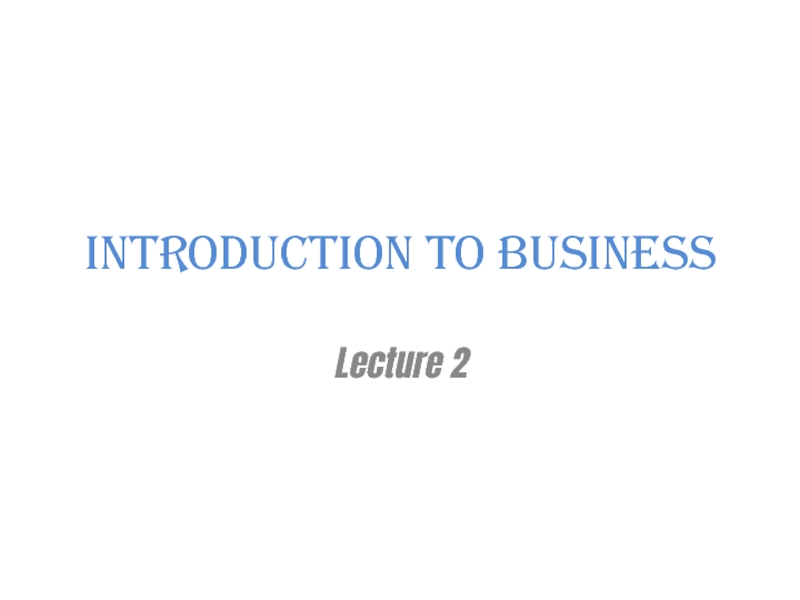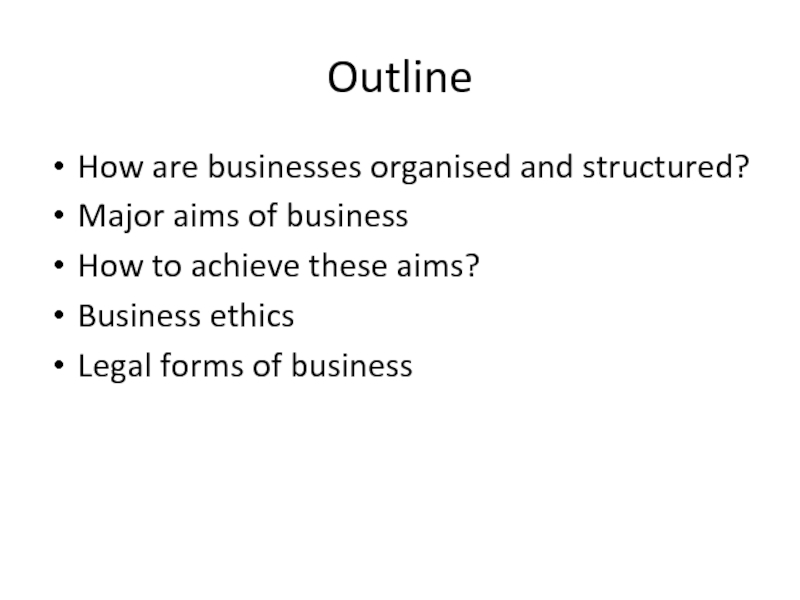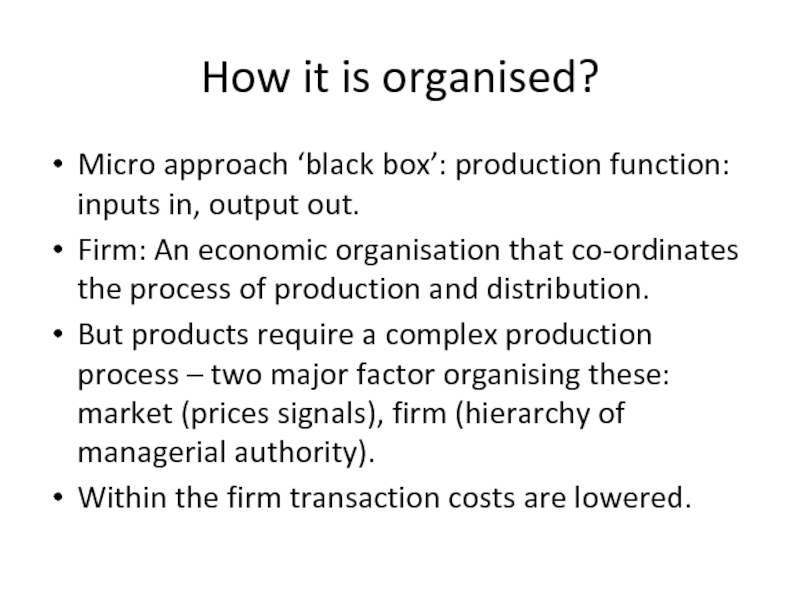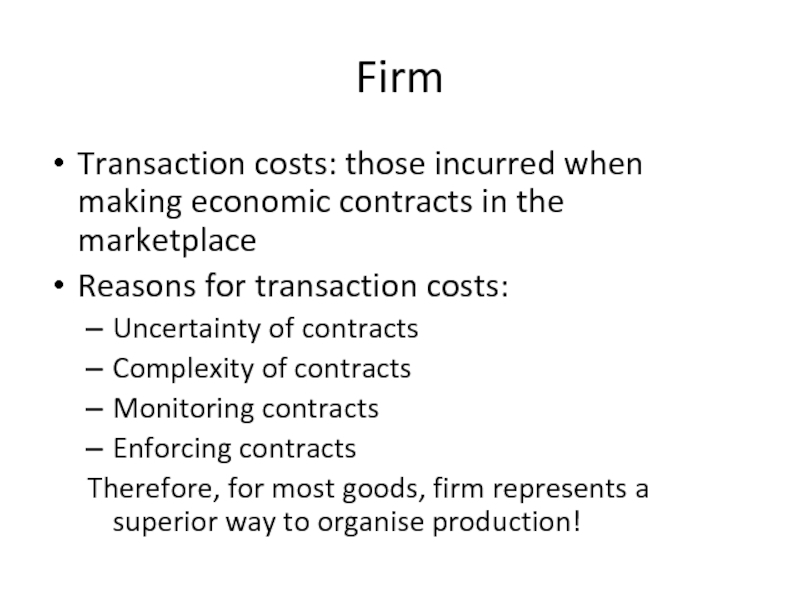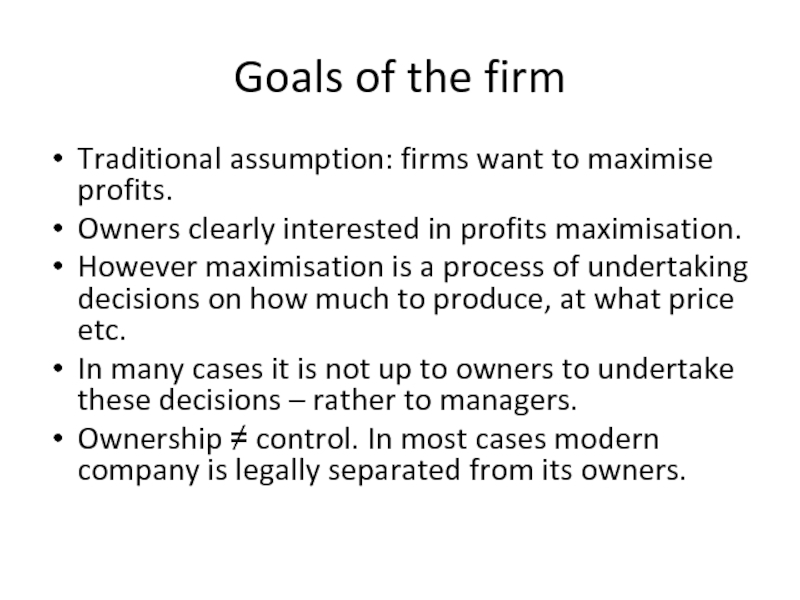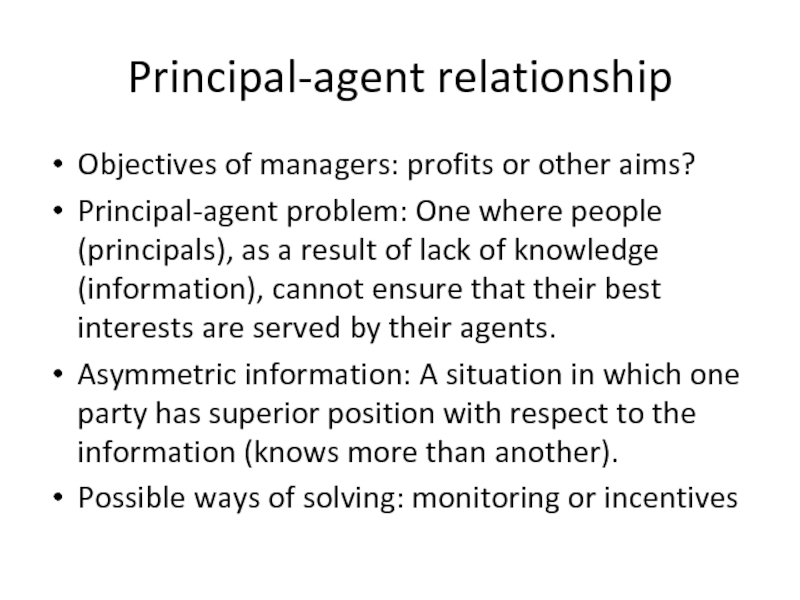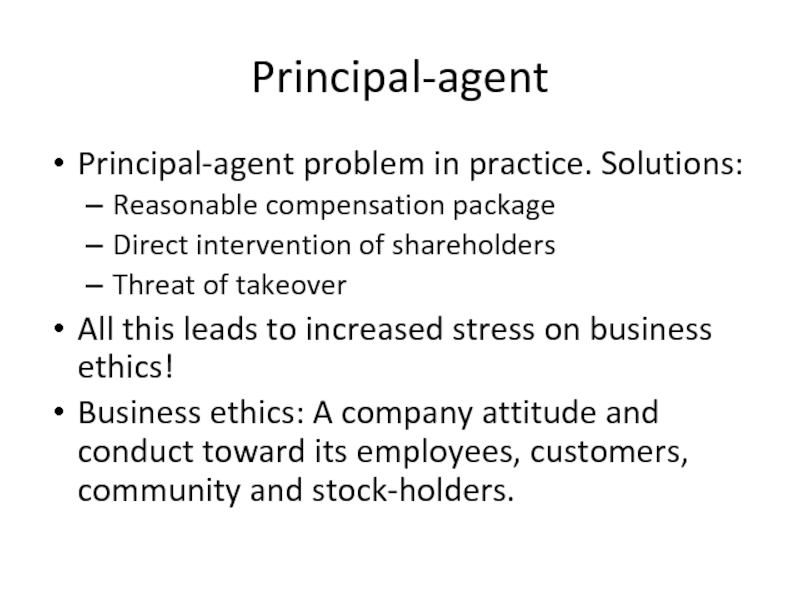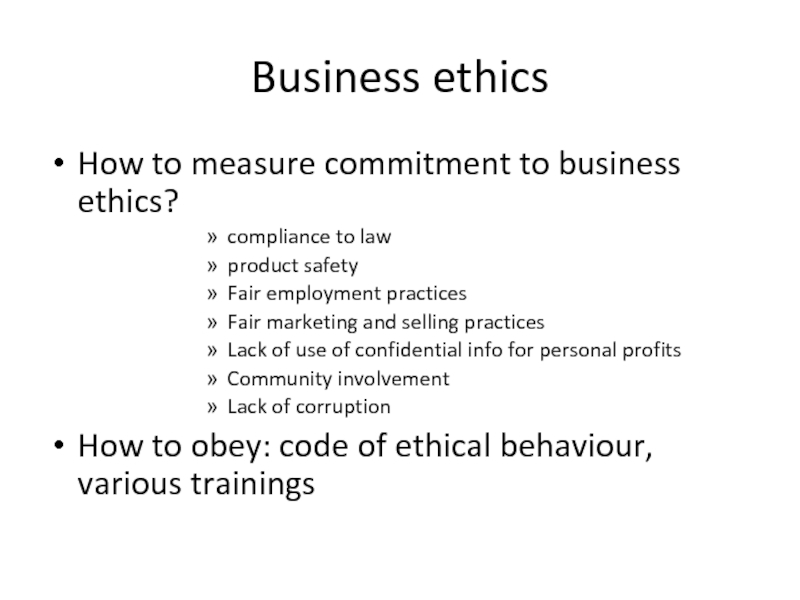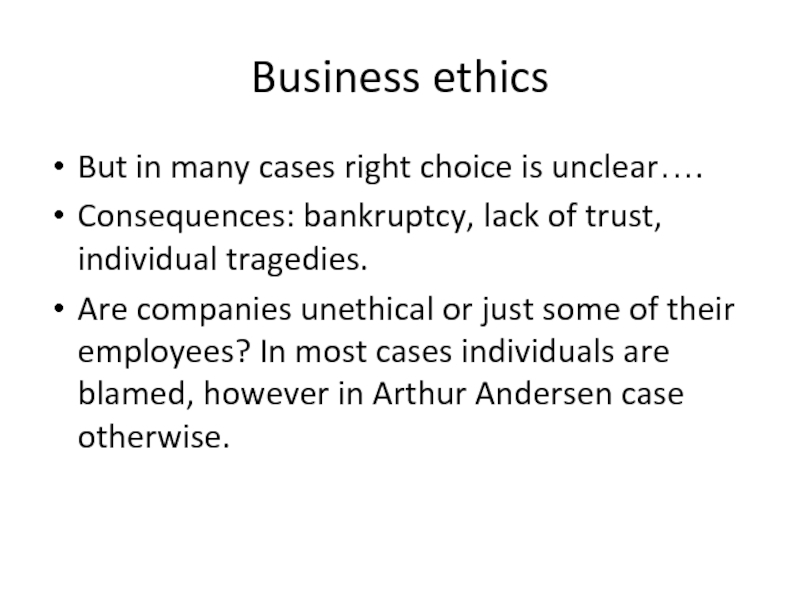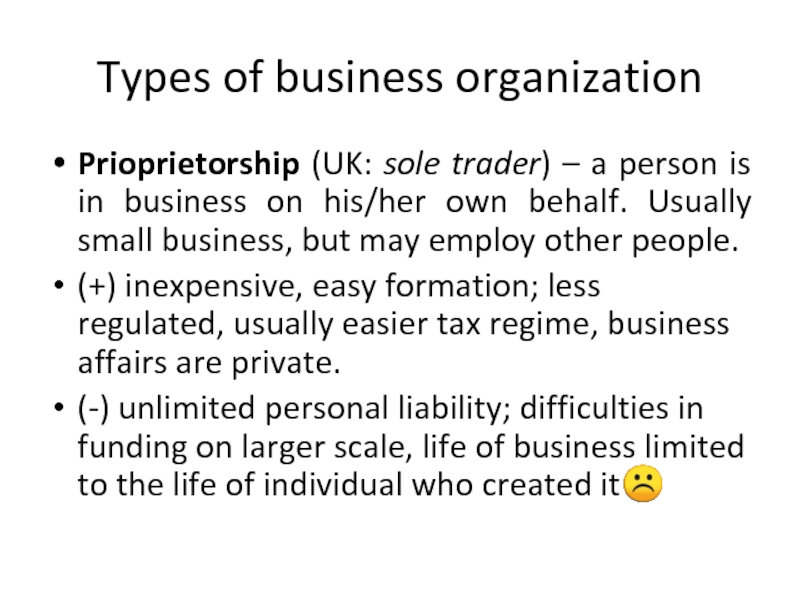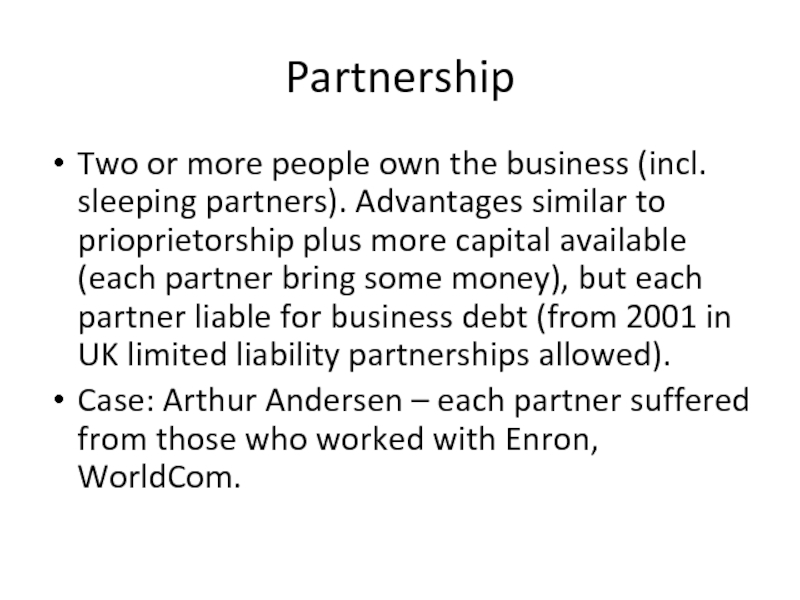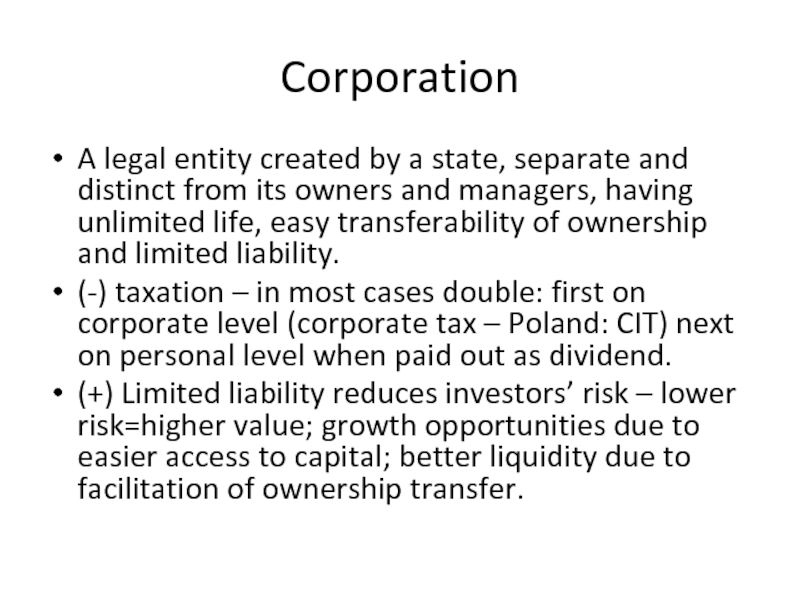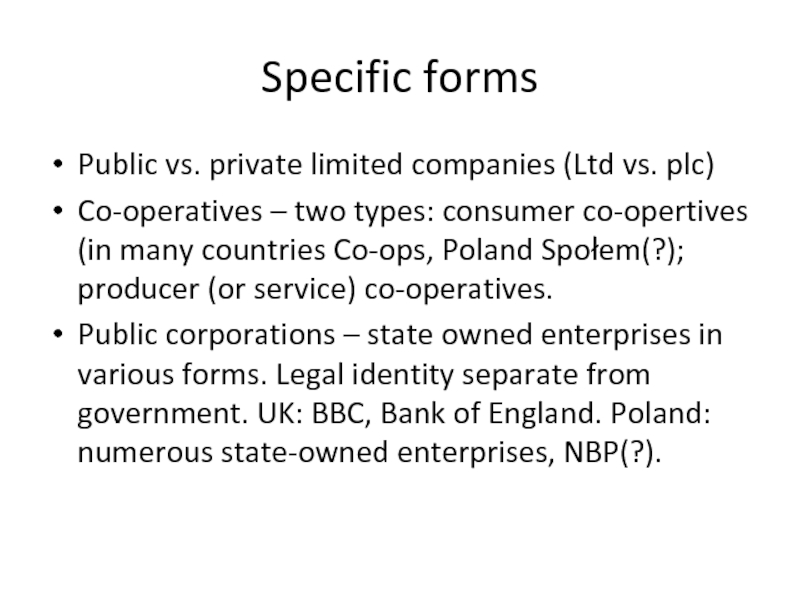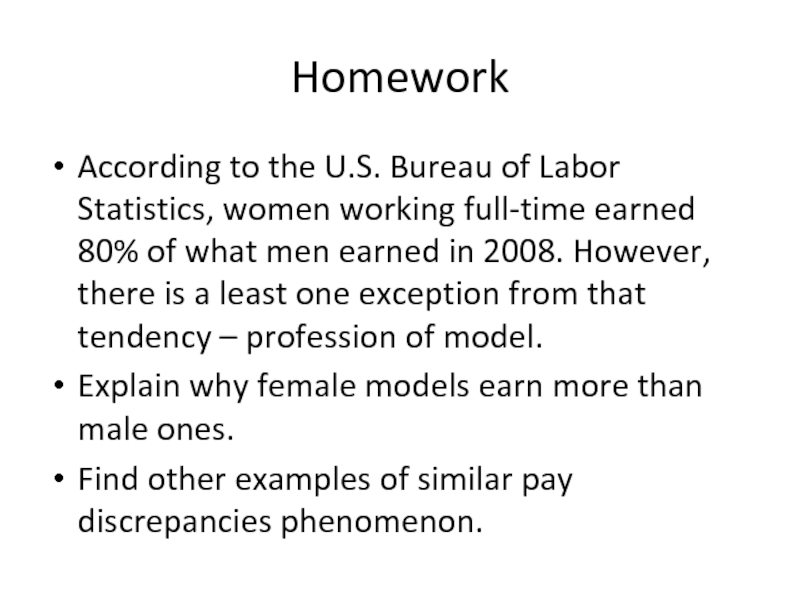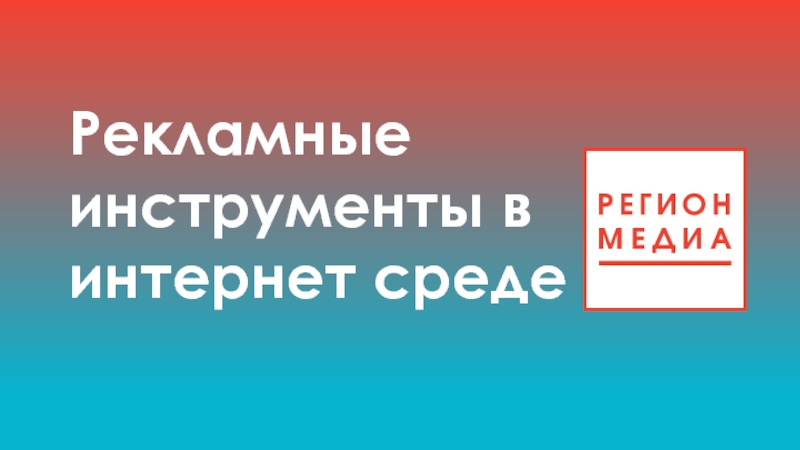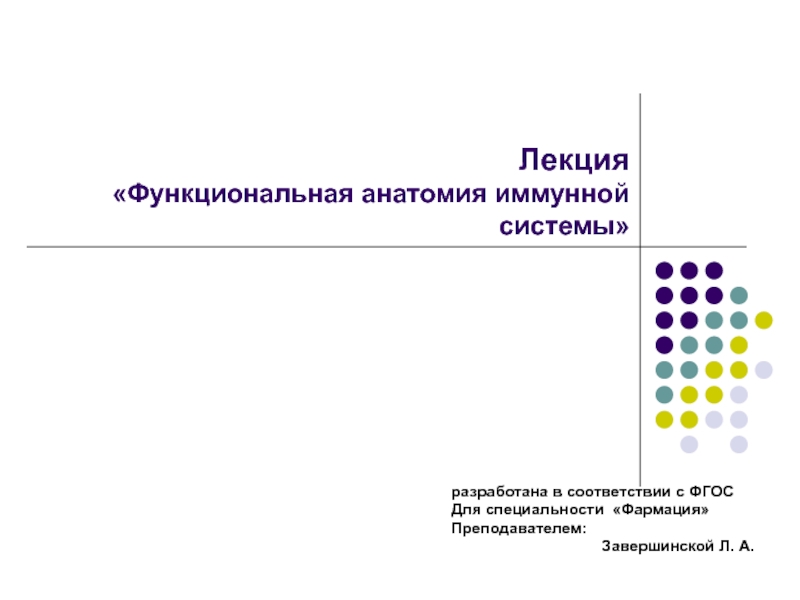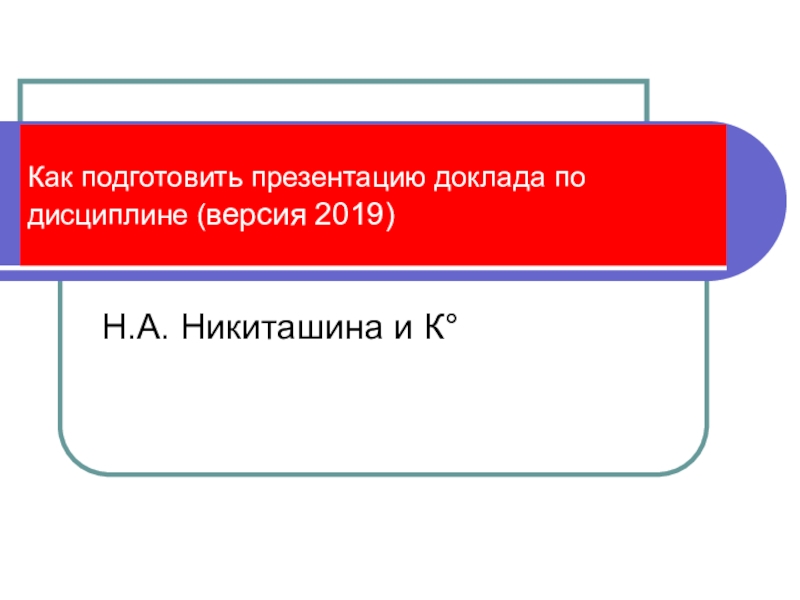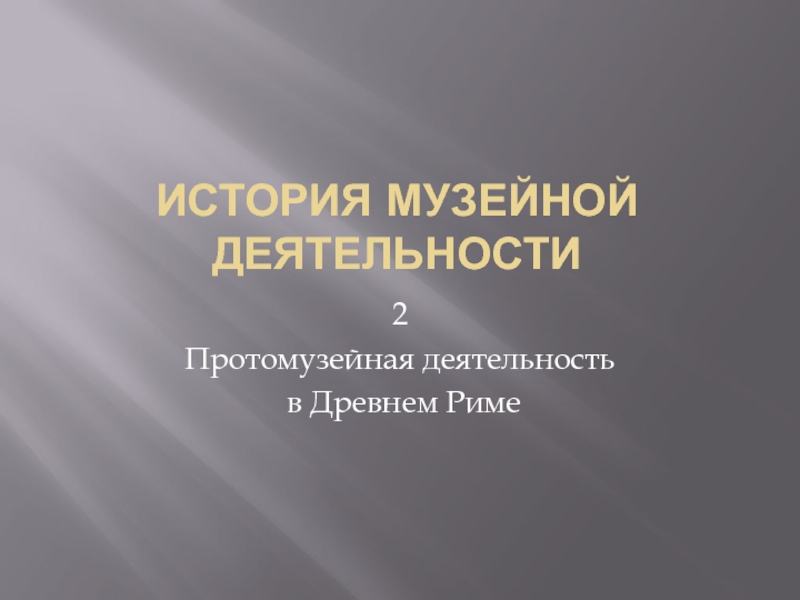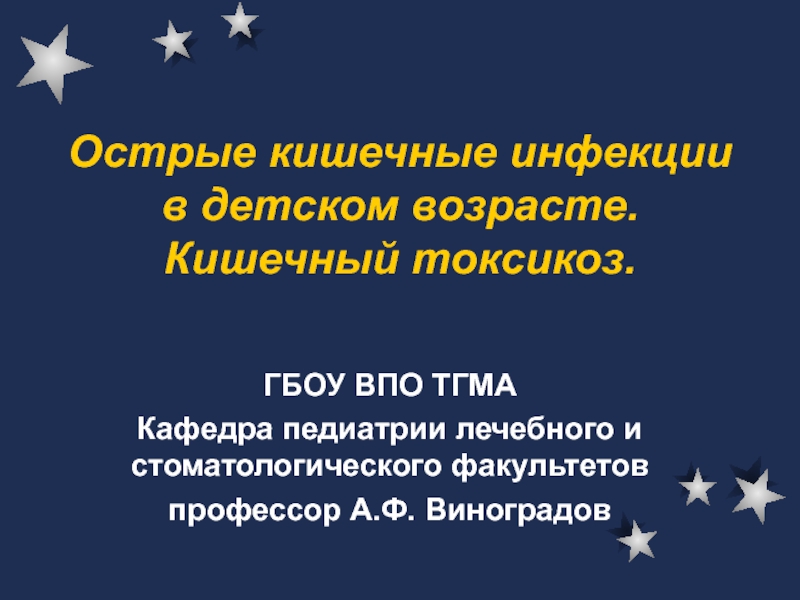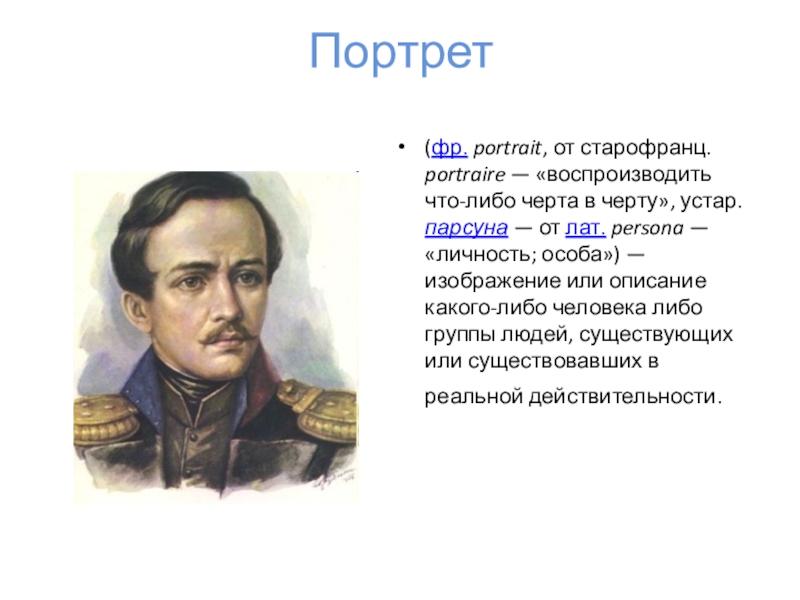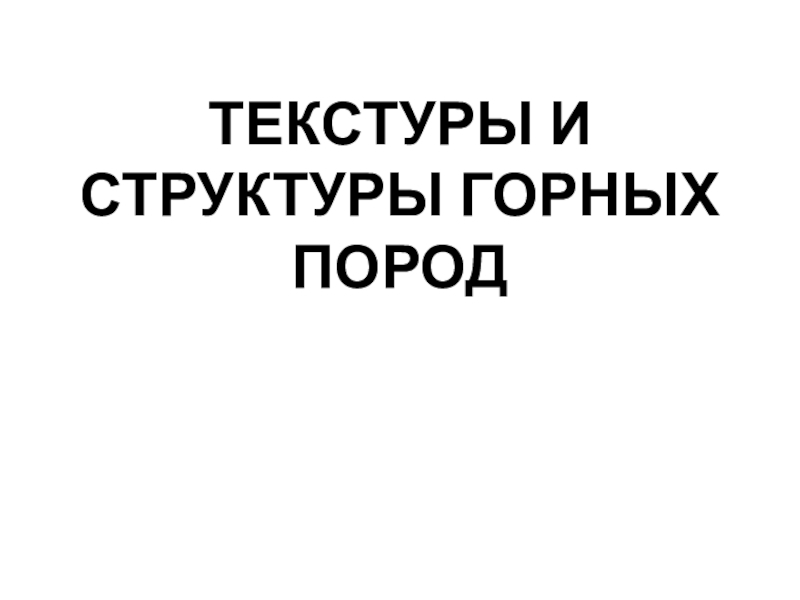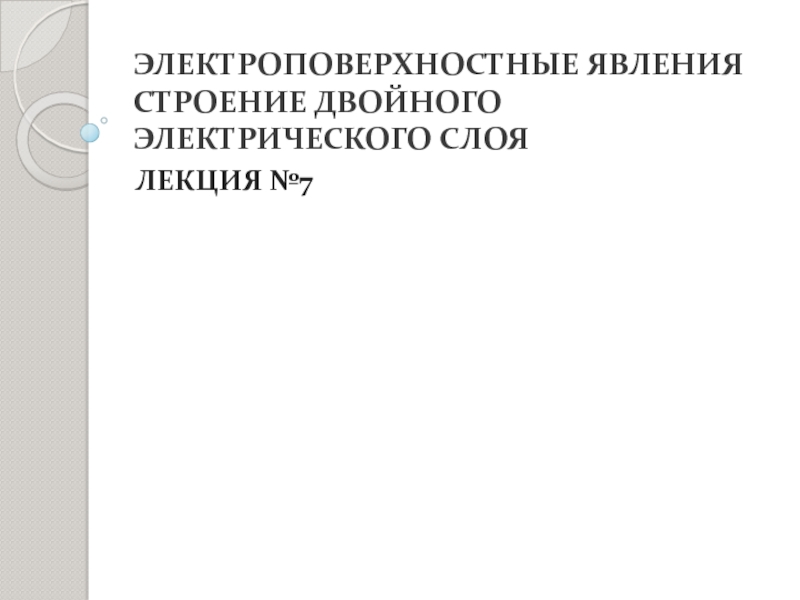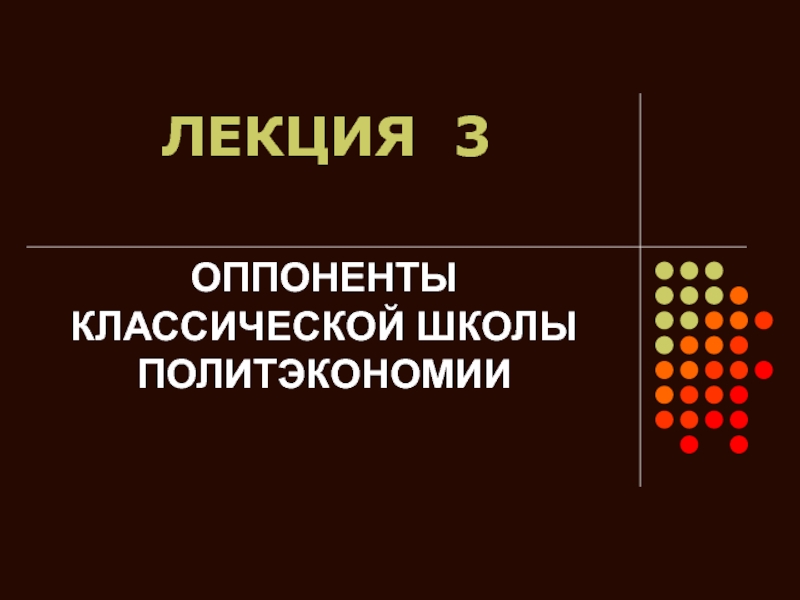Разделы презентаций
- Разное
- Английский язык
- Астрономия
- Алгебра
- Биология
- География
- Геометрия
- Детские презентации
- Информатика
- История
- Литература
- Математика
- Медицина
- Менеджмент
- Музыка
- МХК
- Немецкий язык
- ОБЖ
- Обществознание
- Окружающий мир
- Педагогика
- Русский язык
- Технология
- Физика
- Философия
- Химия
- Шаблоны, картинки для презентаций
- Экология
- Экономика
- Юриспруденция
Introduction to business
Содержание
- 1. Introduction to business
- 2. OutlineHow are businesses organised and structured?Major aims
- 3. How it is organised?Micro approach ‘black box’:
- 4. FirmTransaction costs: those incurred when making economic
- 5. Goals of the firmTraditional assumption: firms want
- 6. Principal-agent relationshipObjectives of managers: profits or other
- 7. Principal-agentPrincipal-agent problem in practice. Solutions:Reasonable compensation packageDirect
- 8. Business ethicsHow to measure commitment to business
- 9. Business ethicsBut in many cases right choice
- 10. Types of business organizationPrioprietorship (UK: sole trader)
- 11. PartnershipTwo or more people own the business
- 12. CorporationA legal entity created by a state,
- 13. Specific formsPublic vs. private limited companies (Ltd
- 14. HomeworkAccording to the U.S. Bureau of Labor
- 15. Скачать презентанцию
OutlineHow are businesses organised and structured?Major aims of businessHow to achieve these aims?Business ethicsLegal forms of business
Слайды и текст этой презентации
Слайд 2Outline
How are businesses organised and structured?
Major aims of business
How to
achieve these aims?
Слайд 3How it is organised?
Micro approach ‘black box’: production function: inputs
in, output out.
Firm: An economic organisation that co-ordinates the process
of production and distribution.But products require a complex production process – two major factor organising these: market (prices signals), firm (hierarchy of managerial authority).
Within the firm transaction costs are lowered.
Слайд 4Firm
Transaction costs: those incurred when making economic contracts in the
marketplace
Reasons for transaction costs:
Uncertainty of contracts
Complexity of contracts
Monitoring contracts
Enforcing
contractsTherefore, for most goods, firm represents a superior way to organise production!
Слайд 5Goals of the firm
Traditional assumption: firms want to maximise profits.
Owners
clearly interested in profits maximisation.
However maximisation is a process of
undertaking decisions on how much to produce, at what price etc.In many cases it is not up to owners to undertake these decisions – rather to managers.
Ownership ≠ control. In most cases modern company is legally separated from its owners.
Слайд 6Principal-agent relationship
Objectives of managers: profits or other aims?
Principal-agent problem: One
where people (principals), as a result of lack of knowledge
(information), cannot ensure that their best interests are served by their agents.Asymmetric information: A situation in which one party has superior position with respect to the information (knows more than another).
Possible ways of solving: monitoring or incentives
Слайд 7Principal-agent
Principal-agent problem in practice. Solutions:
Reasonable compensation package
Direct intervention of shareholders
Threat
of takeover
All this leads to increased stress on business ethics!
Business
ethics: A company attitude and conduct toward its employees, customers, community and stock-holders.Слайд 8Business ethics
How to measure commitment to business ethics?
compliance to
law
product safety
Fair employment practices
Fair marketing and selling practices
Lack of use
of confidential info for personal profitsCommunity involvement
Lack of corruption
How to obey: code of ethical behaviour, various trainings
Слайд 9Business ethics
But in many cases right choice is unclear….
Consequences: bankruptcy,
lack of trust, individual tragedies.
Are companies unethical or just some
of their employees? In most cases individuals are blamed, however in Arthur Andersen case otherwise.Слайд 10Types of business organization
Prioprietorship (UK: sole trader) – a person
is in business on his/her own behalf. Usually small business,
but may employ other people.(+) inexpensive, easy formation; less regulated, usually easier tax regime, business affairs are private.
(-) unlimited personal liability; difficulties in funding on larger scale, life of business limited to the life of individual who created it
Слайд 11Partnership
Two or more people own the business (incl. sleeping partners).
Advantages similar to prioprietorship plus more capital available (each partner
bring some money), but each partner liable for business debt (from 2001 in UK limited liability partnerships allowed).Case: Arthur Andersen – each partner suffered from those who worked with Enron, WorldCom.
Слайд 12Corporation
A legal entity created by a state, separate and distinct
from its owners and managers, having unlimited life, easy transferability
of ownership and limited liability.(-) taxation – in most cases double: first on corporate level (corporate tax – Poland: CIT) next on personal level when paid out as dividend.
(+) Limited liability reduces investors’ risk – lower risk=higher value; growth opportunities due to easier access to capital; better liquidity due to facilitation of ownership transfer.
Слайд 13Specific forms
Public vs. private limited companies (Ltd vs. plc)
Co-operatives –
two types: consumer co-opertives (in many countries Co-ops, Poland Społem(?);
producer (or service) co-operatives.Public corporations – state owned enterprises in various forms. Legal identity separate from government. UK: BBC, Bank of England. Poland: numerous state-owned enterprises, NBP(?).
Слайд 14Homework
According to the U.S. Bureau of Labor Statistics, women working
full-time earned 80% of what men earned in 2008. However,
there is a least one exception from that tendency – profession of model.Explain why female models earn more than male ones.
Find other examples of similar pay discrepancies phenomenon.
